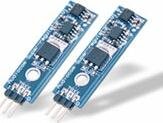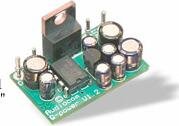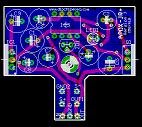Hi everyone,
I have completed the layout for a 3-terminal Super Audio Regulator. (I Hope!)
The design was very generously given to me by ALW.
from ALW Audio
I modified his design slightly to make it fit into a 3 terminal
78xx and 79xx footprint. (But I still have the original option of
the sense pins, if you hardwire them)
This voltage regulator has a normal linear pre-regulator that could be removed if needed, followed by a Walt Jung super low noise voltage regulator.
Dale (harvardian) and I, are going to try to offer this board (and a negative version) as a kit.
I named it the APOX-JR+ and APOX-JR-
I posted pictures of the layouts, so I would really like some feedback before I finalize the board layouts.
You can see the designhere
Is anyone interested in a board like this?
Thanks,
Craig Beiferman
I have completed the layout for a 3-terminal Super Audio Regulator. (I Hope!)
The design was very generously given to me by ALW.
from ALW Audio
I modified his design slightly to make it fit into a 3 terminal
78xx and 79xx footprint. (But I still have the original option of
the sense pins, if you hardwire them)
This voltage regulator has a normal linear pre-regulator that could be removed if needed, followed by a Walt Jung super low noise voltage regulator.
Dale (harvardian) and I, are going to try to offer this board (and a negative version) as a kit.
I named it the APOX-JR+ and APOX-JR-
I posted pictures of the layouts, so I would really like some feedback before I finalize the board layouts.
You can see the designhere
Is anyone interested in a board like this?
Thanks,
Craig Beiferman
Who's design
Has anybody asked Walt Jung about using his design (and it sure looks like his design to me) for commercial purposes? A magazine is selling the boards for his regulator with his permission if i am not mistaken.
I know you have the mounting foot print but, do you really think that thing is going to fit in someone equipment as an after market mod? ITS HUGE
You might want to see what the competition is doing..........
Has anybody asked Walt Jung about using his design (and it sure looks like his design to me) for commercial purposes? A magazine is selling the boards for his regulator with his permission if i am not mistaken.
I know you have the mounting foot print but, do you really think that thing is going to fit in someone equipment as an after market mod? ITS HUGE
You might want to see what the competition is doing..........
Attachments
Re: Who's design
Fred, do you have any info about the picture you have attached (small SMD regulator pcb)?
Fred Dieckmann said:Has anybody asked Walt Jung about using his design (and it sure looks like his design to me) for commercial purposes? A magazine is selling the boards for his regulator with his permission if i am not mistaken.
I know you have the mounting foot print but, do you really think that thing is going to fit in someone equipment as an after market mod? ITS HUGE
You might want to see what the competition is doing..........
Fred, do you have any info about the picture you have attached (small SMD regulator pcb)?
Has anybody asked Walt Jung about using his design
Fred,
I guess I was assuming it was O.K. to use the design because it was posted on EDN
under the title DESIGN IDEAS.
He also wrote the article under the Analog Devices name.
So I am assuming his intention is to get people to use the analog devices chip (AD797) in the article, which I will do.
I'm also guessing if you asked Analog Devices who owned the design, they wouldn't say Walt.
ITS HUGE
Its only 1.75" wide by 1.5" tall. I don't think thats very big.
I blew up the layout for readability.
Thanks for your comments,
Craig Beiferman
Re: Who's design
Fred,
The " Jung" regulators come from a 4-part article in Audio Amateur magazine (now AudioXpress) 1-4 1995 by Walt, the undersigned and Gary Galo. It was based on an earlier article by Mike Sulzer in Audio Amatear 2/80, and my own article (A wideband power supply) in AA 1/87. The PCB was designed by me and is being sold by Old Colony Sound Lab (an affiliation of AudioXpress).
So, even if the PCB design is new, the schematic is the result of a colloborative effort of several people. I personally have no problem with this, but Walt might see it differently. I don't know how to reach him though (except through AudioXpress) as he seems to have retired from Analog Devices.
Jan Didden
Fred Dieckmann said:Has anybody asked Walt Jung about using his design (and it sure looks like his design to me) for commercial purposes? A magazine is selling the boards for his regulator with his permission if i am not mistaken.
I know you have the mounting foot print but, do you really think that thing is going to fit in someone equipment as an after market mod? ITS HUGE
You might want to see what the competition is doing..........
Fred,
The " Jung" regulators come from a 4-part article in Audio Amateur magazine (now AudioXpress) 1-4 1995 by Walt, the undersigned and Gary Galo. It was based on an earlier article by Mike Sulzer in Audio Amatear 2/80, and my own article (A wideband power supply) in AA 1/87. The PCB was designed by me and is being sold by Old Colony Sound Lab (an affiliation of AudioXpress).
So, even if the PCB design is new, the schematic is the result of a colloborative effort of several people. I personally have no problem with this, but Walt might see it differently. I don't know how to reach him though (except through AudioXpress) as he seems to have retired from Analog Devices.
Jan Didden
Has anybody asked Walt Jung about using his design (and it sure looks like his design to me) for commercial purposes? A magazine is selling the boards for his regulator with his permission if i am not mistaken.
audioXpress sell PCB's, as far as I'm aware Walt does not benefit from this.
Walt is well aware of the other's using what I suspect is his basic design and from my own questions he has no problem with it being marketed commercially by others.
I know, I'm doing it and have asked after the guilt got to me
I'm not sure the Audiocom reg's have the full Jung cct, but they are a wideband op-amp based unit. The tracking pre-reg's and other mods (bootstrapping) bring benefits that the commercial units are not implementing.
Some are still using the AD797

Companies such as Trichord are also using similar schemes.
Andy.
P.S. Jan - Walt has retired from ADI
If we exclude the opamp itself (very low noise type), what is so special really? What about the output stage? If a regular emitter follower is used, what enhancements do I get with the "Jung" output stage?
My low noise (16 µV) QSXPS PS is the same except for that the opamp is fed before the regulator with a huge capacitor (compared to the current consumption). If I change the opamp I will proably get lower noise.
My low noise (16 µV) QSXPS PS is the same except for that the opamp is fed before the regulator with a huge capacitor (compared to the current consumption). If I change the opamp I will proably get lower noise.
If we exclude the opamp itself (very low noise type), what is so special really? What about the output stage? If a regular emitter follower is used, what enhancements do I get with the "Jung" output stage?
As always with audio, the final circuit sound has little to do with the topology used.
The benefit of the o/p stage is primarily that it allows a start-up mechanism for the bootstrapped regulator, and the subsequent (big) benefits of that.
Andy.
Re: Re: Who's design
I have had contact with Mr. Jung recently (April) about FNDR filter.janneman said:I don't know how to reach him though (except through AudioXpress) as he seems to have retired from Analog Devices.
regulator
Well, ALW will probably beat me to this (Hi Andy!) but believe me, in this designb EVERY (almost) component is tweaked, the reference, the opamp, the caps, the feedback circuitry, and yes, the bootstrapping of the opamp supply. Each giving measurable improvements and, as I have heard from other users, audible differences.
On top of that, the PCB layout has a MAJOR impact on the performance. A couple of wrongly routed traces can negate that expensive opamp or cap completely.
This is not for the faint at heart. If you see designs still using the 797 they either don't use remote sensing or use excess compensation to keep it stable or take a gamble.
Do yourself a favor and buy the 1995 backissue series of AudioXpress. Well worth the 20 $ or so it costs.
Jan Didden
Well, ALW will probably beat me to this (Hi Andy!) but believe me, in this designb EVERY (almost) component is tweaked, the reference, the opamp, the caps, the feedback circuitry, and yes, the bootstrapping of the opamp supply. Each giving measurable improvements and, as I have heard from other users, audible differences.
On top of that, the PCB layout has a MAJOR impact on the performance. A couple of wrongly routed traces can negate that expensive opamp or cap completely.
This is not for the faint at heart. If you see designs still using the 797 they either don't use remote sensing or use excess compensation to keep it stable or take a gamble.
Do yourself a favor and buy the 1995 backissue series of AudioXpress. Well worth the 20 $ or so it costs.
Jan Didden
Re: Jung Regulator Design
" There is nothing new under the sun, but there is a lot we haven't seen yet" -- Anon
Jan Didden
Norbert said:Hi,
the later called Jung Design has been used by Akihiko Kaneda in the seventies already within all of his DC-Amplifiers published at that time using 709 opamps.
Best regards,
Norbert
" There is nothing new under the sun, but there is a lot we haven't seen yet" -- Anon
Jan Didden
Oki doki, I had some startup problems with my negative regulator but I suspect with a true rail-to-rail opamp would solve the problem. The opamp I used LM324 can have the inputs at ground but not at the power supply voltage.ALW said:
As always with audio, the final circuit sound has little to do with the topology used.
The benefit of the o/p stage is primarily that it allows a start-up mechanism for the bootstrapped regulator, and the subsequent (big) benefits of that
bootstrapping
peranders,
The real benefit comes from the bootstrapping the op-amp.
This means that the op-amp is powered directly from the regulated output voltage of the circuit.
Normally, if the op-amp were powered from the supply, any ripple on the op-amp supply would show up as noise on the output.
But now, the regulated output powers the op-amp,
and the regulated output is also the feedback to the op-amp.
So the noise is now much more common mode, and hence the
big 30 to 35 dB improvement over typical regulators.
Thanks,
Craig Beiferman
peranders,
The real benefit comes from the bootstrapping the op-amp.
This means that the op-amp is powered directly from the regulated output voltage of the circuit.
Normally, if the op-amp were powered from the supply, any ripple on the op-amp supply would show up as noise on the output.
But now, the regulated output powers the op-amp,
and the regulated output is also the feedback to the op-amp.
So the noise is now much more common mode, and hence the
big 30 to 35 dB improvement over typical regulators.

Thanks,
Craig Beiferman
Hi Jan,
I've been corresponding with Craig privately about those issues (e.g. PCB layout).
With uV error signals, the PCB is an essential part of the circuit!
I don't mine helping for the greater good of the DIY community though, and have wanted to do an SMD version ever since I did my board
I reckon there's a good market for a 3-terminal replacement that crams as much performance as we can muster into a suitable footprint.
Andy.
I've been corresponding with Craig privately about those issues (e.g. PCB layout).
With uV error signals, the PCB is an essential part of the circuit!
I don't mine helping for the greater good of the DIY community though, and have wanted to do an SMD version ever since I did my board
I reckon there's a good market for a 3-terminal replacement that crams as much performance as we can muster into a suitable footprint.
Andy.
peranders said:
Oki doki, I had some startup problems with my negative regulator but I suspect with a true rail-to-rail opamp would solve the problem. The opamp I used LM324 can have the inputs at ground but not at the power supply voltage.
It's not that Per. If the opamp supply is bootstrapped, it can not regulate the output voltage away from zero, because there is no supply for the opamp without the output voltage. It's a matter of the chicken and the egg, who gets there first.
Jan Didden
Re: regulator
Also the pcb layout, normal Kirchoffs laws, and normal science, no voodoo like at >GHz.
I think the Jung design is pretty much normal engineering science, no tweaking at all. There are better references for instance.janneman said:Well, ALW will probably beat me to this (Hi Andy!) but believe me, in this designb EVERY (almost) component is tweaked, the reference, the opamp, the caps, the feedback circuitry, and yes, the bootstrapping of the opamp supply. Each giving measurable improvements and, as I have heard from other users, audible differences.
On top of that, the PCB layout has a MAJOR impact on the performance. A couple of wrongly routed traces can negate that expensive opamp or cap completely.
Also the pcb layout, normal Kirchoffs laws, and normal science, no voodoo like at >GHz.
- Status
- This old topic is closed. If you want to reopen this topic, contact a moderator using the "Report Post" button.
- Home
- Design & Build
- Parts
- 3 terminal Jung Super Regulator Kit


